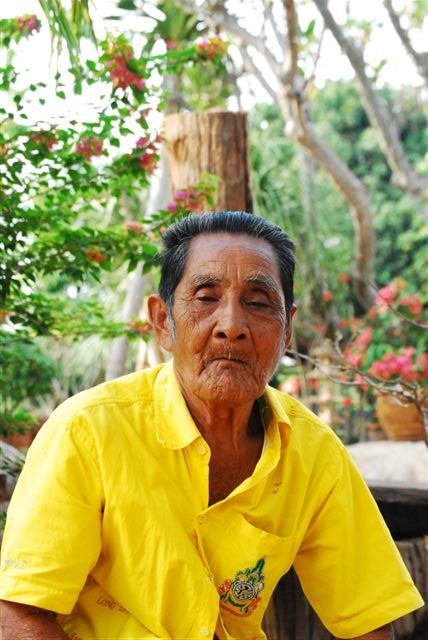2018 visit to Kanchanaburi by DRIG group:
THONG YU

On 28 February 2008, when in the vicinity of Pung Waan Resort Kwai Noi, I had the privilege of interviewing Thong Yu (in Thai means Long Life). The interview was facilitated by Khun Vivatchai Wongsuvat (Travel Agent of Bangkok who arranges the Defence Reserves Association trips to Thailand for Remembrance Day each year). Thong Yu’s second son (48 Years) also assisted.
According to Thong Yu, in 1942 the Japanese approached Malay families offering to take able sons to do contract work. They allowed one son to remain with the family and, in the case of Thong Yu’s family that was the eldest son. A payment of Thai Baht 600 was made to Thong Yu’s parents.
As a 16 year old he was sent to Thailand and subsequently became a slave labourer on the Burma Thailand Railway. He and a number of other young males from his area were moved to Thailand by train in open cattle trucks. Their destination in Thailand was Non Pladuk, which was the point where the railway to Burma branched off the main line connecting Bangkok and Singapore.
Whilst forced to work on the railway he had to break stone for ballast, lay sleepers and also lay the steel rail lines themselves. It is assumed that this was mainly in the area between Non Pladuk and Kanburi (now known as Kanchanaburi). However Thong Yu assured me that he worked between Non Pladuk and Konyu Cutting (Hellfire Pass).
He says that treatment by the Japanese was reasonable, but, treatment by the Korean guards was bad. Many were forced to work even when sick. Many died from Malaria and he was aware of large numbers who died from Cholera. They had 3 meals a day and the ingredients were rice with salted fish or meat. The Romusha lived in tents and were constantly under guard. He does not remember any women or children being with them nor does he remember any British or Australian doctors or medical orderlies being with them.
After labouring for about 2 years, when in the vicinity of Konyu, he and about 50 others escaped. They jumped into the river and used bamboo as floatation devices. When they escaped, the Japanese or Korean guards machine gunned them in the water.
He floated down the river for some days, finally stopping at Ban Kao (Thai meaning said to be “White Crocodile”). Here he was cared for by some monks until the war ended. He remembers the allied bombing raids on the Tamarkan Bridge and the Wampo bridging (Viaduct). He also remembered the image and sound of the first train (steam) which he saw on the line. He actually portrayed the “Clickety-clack” sound of the train passing over the rail joints.
https://en.wikipedia.org/wiki/Ban_Kao
After the war he became a Mahout. With his elephant he hauled logs out of the jungle. He married a lady whose family lived at Ban Kao. They had 6 children the eldest of whom is 51 years. His wife died around 2002 and in 2008 he resides near Namtok.
He is visited each January by a former Japanese officer, who may be Nagase Takashi. On one occasion his Japanese visitor took him to his home town on Malaya – Kota Bahru. However, he did not recognise the place nor did he know anyone there.
Thong Yu is now over 80 years and it was a pleasure to interview this dignified gentleman.
Interviewer – Lt Col (Retired) Peter Winstanley OAM RFD JP
Photographer – Major Beverley Poor RFD
Facilitators – Khun Vivatchai Wongsuvat, Pacific Horizon Travel, Bangkok
March 2008
Part 2: British comments
In his excellent book, British Lt John Coast relates episodes of his visits to some of the romusha camps in the Thai Highlands. Even those that were not ravaged by cholera were in dreadful condition. A total lack of infrastructure and organization led to horrible sanitary conditions. He writes that: “If the British Empire continues to be worthy of its name, let it never forget the responsibility it owes to those thousands of its citizens who deserve redress and a guarantee of future security…”. Unfortunately, that was not to be. As Professor Boggett also laments, the British gov’t labored tirelessly to repatriate its Commonwealth POWs but utterly ignored the romusha mot of whom were British subjects.
The one concession that was made came in the form of medical ‘volunteers’ from Singapore brought in as part of some of the final groups to leave there. They seemed to consist mainly of Australian doctors and attendants. Many found themselves ‘responsible’ for camps of thousands of starving and debilitated Asians whose languages they did not speak and for whom they had little to offer but compassion.
Those who survived the horror of their jungle camps and were eventually consolidated to Kanchanaburi were still among the most neglected at that camp. Per the report of local Thai citizens, they continued to die in great numbers long after the TBR was completed. Even upon the end of the war, their plight hardly changed. As food, uniforms and supplies were air-dropped to the POWs just a short distance away, they received nothing. We will never know the stories of how they actually survived, but I’d guess that it was due to the compassion and aid of the citizens of Kanchanaburi. It is recorded that many romusha remained at the KAN camp well into 1947. It was up to them to find a way to head south. No government aid nor transportation was on offer!
https://biblioasia.nlb.gov.sg/vol-18/issue-3/oct-dec-2022/grandfather-romusha-thai-burma-railway/
